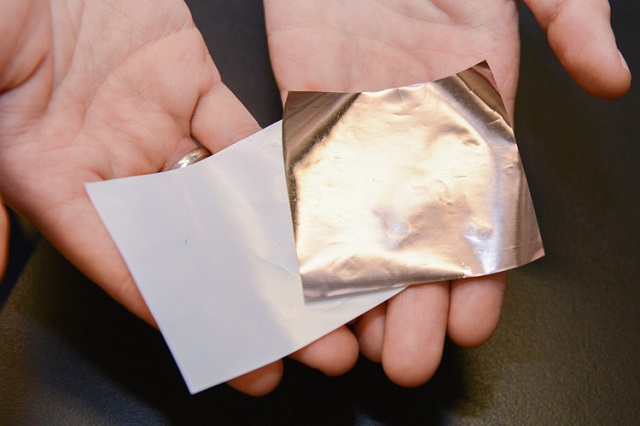 The ultrathin copper sensor is deposited atop a conventional battery separator (white square) as part of an early warning system to alert users that a lithium-ion battery is overheating. Credit: Mark Shwartz
The ultrathin copper sensor is deposited atop a conventional battery separator (white square) as part of an early warning system to alert users that a lithium-ion battery is overheating. Credit: Mark Shwartz
A “smart" lithium-ion battery developed by scientists at Stanford University has a warning system that alerts users in advance if the battery is getting overheated and may burst into flames.
Lithium-ion batteries are widely used in many applications ranging from electronic devices, cellphones, and laptops to cars and airplanes.
A lithium-ion battery is made up two electrodes that have a very thin polymer separator between them. These electrodes are usually a lithium metal-oxide cathode and a carbon anode, while the polymer material separator is the same as that found in plastic bottles.
This separator is porous and allows the flow of lithium ions between the electrodes during the charging and discharging cycles.
The safety of lithium-ion batteries has been questioned by two well-publicized incidents. Battery packs in two Boeing 787 Dreamliner airplanes caught fire and over a dozen fires were reported in Sony consumer laptops.
Tiny metal impurities or dust can infiltrate into the batteries and pierce the separator. This could lead to short-circuit in the batteries leading to fire hazards. Further, overcharging the battery and charging at low temperature can also short the battery.
When the battery is overcharged, the lithium ions get stuck to the anode. They pile up in the form of dendrites, which are chains of lithium metal. Dendrites have the ability to penetrate the separator and go to the cathode leading to shortening of the battery.
The Stanford researchers wanted to fabricate a smart separator that could detect any symptoms of shortening well before the dendrites made contact with the cathode. They created a third electrode between the anode and cathode by applying a copper nanolayer on one side of the polymer separator. When the dendrites reached the copper coating the voltage became zero and provided warning about the problem in the battery.
The likelihood of a bad thing like that happening is maybe one in a million. That's still a big problem, considering that hundreds of millions of computers and cellphones are sold each year. We want to lower the odds of a battery fire to one in a billion or even to zero.
Yi Cui, Associate Professor of Materials Science and Engineering
Study of the copper coating and the polymer separator revealed that the thin coating layer of 50nm did not affect the performance of the battery but benefitted in terms of safety. This novel technology could also be used in other metal batteries.
The National Science Foundation Graduate Research Fellowship Program has provided support for this study which has been published in the journal, Nature Communications.
References